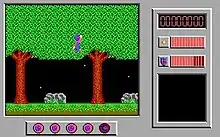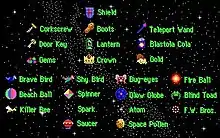The Adventures of Captain Comic
The Adventures of Captain Comic is a platform game initially released for MS-DOS and compatible systems in 1988 as shareware.[1] Developed by Michael Denio, it was one of the first side-scrolling platform games for IBM PC compatibles. A version for the Nintendo Entertainment System was later published by Color Dreams as an unlicensed title.
| The Adventures of Captain Comic | |
|---|---|
 NES box cover | |
| Publisher(s) | Michael Denio (shareware) Color Dreams (NES) |
| Designer(s) | Michael Denio |
| Platform(s) | MS-DOS, NES |
| Release | January 5, 1988 |
| Genre(s) | Platform |
| Mode(s) | Single-player |
Plot
Captain Comic is on a mission to the planet Tambi, where the quest begins. Comic must find three artifacts: the Mystical Gems of Lascorbanos, the Thousand Coins of Tenure, and the Crown of the Ages. To find them, he must travel through many varied environments. The game is completed when Comic is in possession of all three treasures.
Gameplay


The game is divided into a number of major areas (see list above), and each area is divided generally into three smaller "zones". Transitioning between zones plays a short tune and marks a "safe point", since all enemies are removed from the screen and Comic's position is saved.
Comic has twelve "shield" points (health), but each time an enemy hits him, two points are removed. Once the shield has been reduced to 0, Comic is still alive, but will die on the next hit. Occasionally, shields can be found which instantly replenish Comic's health to full, or if it is already full, grant him an extra life. Comic starts the game with four lives, and can go up to a maximum of five. If Comic is killed by either falling off the bottom of the screen, or being hit with no shield points remaining, a life is lost and he is returned to the point where he last entered this zone. If all lives are lost, the game ends.
The games' enemies exhibit different behaviour, ranging from simply bouncing off the walls and pre-set paths to creatures who seek the player out and turn to follow Comic as he passes by. Enemies are generally restricted to their own area (Space Pollen is only on the moon, for example), and a few move faster than the others. All enemies have the same gameplay property which is that if they touch Comic, the enemy is destroyed and Comic suffers two points of shield damage. Once he has picked up a Blastola Cola (the first one is found at the very start of the game), Comic may shoot at enemies. If he hits an enemy, it is destroyed and points are scored.
There is a maximum of 5 extra lives, and any player earning an extra life while already at maximum receives a full shield charge and a large point bonus. The player gets an extra life for every 50,000 points earned, a bonus still in effect if the player has won the game and has enough extra lives to go over this target. (Lives can also be awarded for recharging shields while at full, or picking up treasure items.)
Development
Michael Denio previously wrote an interactive demo of a platform game called The Adventures of Captain Pixel of the Galactic Security Patrol in 34010 AD for a TMS34010 coprocessor board.[2] The credits screen has a 1987 copyright notice for the graphics.
Denio wrote in the introduction to the Captain Comic manual:
The Adventures of Captain Comic started out as an experiment to test the viability of two theories, the first as to whether a real arcade type game can be done on a standard IBM PC with an EGA card, and secondly, given the first can be done, if it is possible to make any money doing it. Well, I've come to a conclusion on the second point, but I'll let you judge the first point for yourself.
Music
The original theme song for Captain Comic was a rendition of the United States Marine Corps Hymn. The song was replaced in Version 5 (the final revision of the game, released in 1991), by George Frideric Handel's Harpsichord Suite in D Minor, HWV 428, Air. The NES version of the soundtrack is composed entirely of classical music.[3]
Legacy
A sequel from the same author was published in 1990 as Captain Comic II: Fractured Reality.
In 2012, PC World called Captain Comic the twelfth greatest shareware game of all time, writing that "it inspired many other shareware authors, including the folks who would later create Commander Keen."[4]
The original game was cloned for the SAM Coupé. It was also cloned as The Adventures of Pioneer Kseniauk in 1990 by a team of Ukrainian programmers.[5]
References
- Cobbett, Richard (September 14, 2013). "Saturday Crapshoot: Quickies Week II". PC Gamer. Retrieved July 11, 2016.
"The creator was inspired by Metroid to add an adventure game element to jumping around the levels".
- "The Adventures of Captain Pixel". YouTube.
- Blip, Bloop, Bach? Some Uses of Classical Music on the Nintendo Entertainment System." Music and the Moving Image, Vol. 2, No. 1 (Spring 2009), pp. 40-52
- Edwards, Benj (January 22, 2012). "The 12 Greatest PC Shareware Games of All-Time". PC World.
- Pioneer Ksenia information (in Ukrainian, Russian, and English)